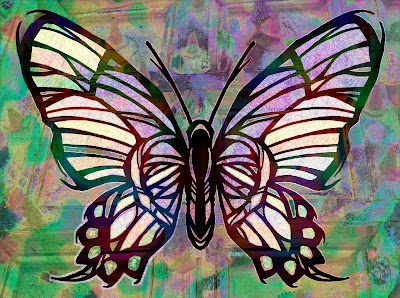My coloration might not be as dark as in the text, but I like my butterfly.
 |
| Colorful Butterfly |
While this started out as a writing blog which has been sorely neglected, it's being converted to another use. Now that I'm learning to use photoshop, I want to post some of my art work. You'll still find the writing blog under the Thinking in Text tab.
 |
| Colorful Butterfly |
At the Paris Expo of 1900, Paul Masson Champagne stunned the world’s oenophiles by winning its prestigious Paris Award. The Masson brand brought the California winery industry (and its Santa Clara Valley appellation) to the forefront of wine lovers worldwide. And that reputation of innovation and hard work forms the basis of Santa Clara Valley’s success in the modern world.
Leaving his family’s reputation and vineyards behind, Paul Masson came to the US in 1878 from the Burgundy region of France. Here he met up with Charles Lefranc, another transplanted Frenchman and winemaker. The two experimented using Lefranc’s imported French vines with grafts from “Mission” vines from nearby Franciscan padres. Their work resulted in great wines that brought business success and celebrity for both Masson and Lafranc in Santa Clara Valley and San Francisco. Masson eventually married Lafranc’s daughter and set up his own winery in the hills above Saratoga. His mountain winery completed in 1905 was named “La Cresta.” The 1906 earthquake destroyed most of the winery and in rebuilding the he acquired the 12th century portal from the ruins of St. Patrick’s Cathedral of San Jose.
From this location he produced fine wines and even supplied sacramental wines during Prohibition. With most of his fortune gone and now a widower by the time Prohibition was repealed, he sold the mountain estate to Martin Ray in 1936. Ray, who had worked at the winery as a youngster, kept the Masson brand and reported that Paul Masson visited his former mountain estate up until his death at 82 in 1943.Martin Ray eventually sold the Masson Brand to the Seagram’s. It’s had several owners since then. An amphitheater was added and the property began its second life as a concert venue.
In the late 1950’s, the Masson brand needed an easily accessible location for its products. So it hired the notable architect John Savage Boles to design a modern tasting cellar to be located on Saratoga Ave. Bolles, noted for Bay Region Modernism, contributed more than 500 different structures including Candlestick Park, the Macy’s at Valley Fair, IBM buildings in SJ, and the Fremont GM plant. The famed photographer Ansel Adams documented the construction of the Champagne Cellars in an exhibition which eventually appeared at the Smithsonian.
The Champagne Cellars were razed in the early 1990’s for a housing development. While the Champagne Cellars have been replaced by housing, the historic Paul Masson Mountain Winery still stands in homage to the legacy and success of the Santa Clara Valley agricultural and winery innovators. On many nights when the lights are visible on the hill off Pierce Road, it’s easy to imagine the wonderful events that have taken place up there over the years. The Mountain Winery still epitomizes fine living with music, entertainment, and of course, a glass of champagne.
Sources: